After Independence the country did not have gallantry awards. The need was felt, accordingly the Adjutant Generals Branch of Indian Army was tasked to come up with various awards for gallantry in the face of enemy. Accordingly the awards was conceived according to the precedence are Param-Vir-Chakra, Maha-Vir-Chakra, Vir Chakra, Sena Medal Gallantry and Mentioned-In-Despatches and approved.
The notable thing in this is the design of Param-Vir-Chakra. Lots of thought process had gone in in design of this gallantry award. It has Vedic connection as it is the ultimate demonstration of valour and the design process is meaningful. No other medal in the world has been designed with so much of thoughts.
Vritra (Ahi meaning Snake in Samskruta) is a Dragon (serpent monster or Demon). He was an ardent bakta (Devotee) of Lord Vishnu. After a severe penance he requested for a boon that he cannot be killed by any known weapon in the world. Lord Vishnu blessed him with the boon. Indra the king of Devas in Devalokha was driven out of heaven (Devalokha) by Vritra. The Demon Vritra has stolen all the water in the world for use by the Asura’s (Demon) Army. This was done by him kill all the living being of the whole world of thirst, draught and hunger leaving no human or God to challenge his place in heaven. Indra though lost all hope of winning his Kingdom approached Lord Maha Vishnu for a help. Lord Maha Vishnu revealed that no known weapon could kill Vritra but the weapon made by the bones of Sage Dadichi.
Sage Dadichi is known to be master of Vedic art of Bramhavidya that would enable him to attain immortality. Indira the king of Devas thought that his position will be insecure due to immortality of Dadichi because of concentration of such powers in the hands of a common man. Ashwini (Gods of Medicine) twins were also targeted by the Lord Indira who were also on the knowhow of Bramhavidya. The Lord Indira swore to kill the man who taught the Bramhavidya to those the Ashwinis. Knowing this the Ashwinis cut off the head of Sage Dadichi and kept a horse’s head on him and hidden the original head of the sage. Indra beheaded the horses head as he was blinded by the wrath. After the Lord Indra left Dadichi was brought back to life by placing the original head of the sage and with the help of Bramhavidya.
The king Kshuva a devotee of Lord Maha Vishnu got into an argument over superiority of Kings over Brahmans and vice-versa. Dadichi punched Kshuva and Kshuva attacked Dadichi with the Thunderbolt. The injured sage was treated by Shukracharya. After getting cured the sage Dadichi performed severe penance on Lord Shiva. Shiva appeared before the sage and granted him three boons. The first one being that the sage Dadichi will never be humiliated, The second on being that he will be killed and the third one being his bones will become as hard as Diamond. After this the sage Dadichi attacked Kshuva who requested the help of Lord Vishnu. Lord Vishnu tricked Dadichi which was understood by the sage and attacked the Gods with Trident. All the Gods except for Lord Vishnu fled the scene. In spite of the difference the sage had respect for the Lord.
When the lord Indra approached the sage Dadichi for help the Sage readily agree despite his difference with the Lord Indra for the sake of Dharma. The sage Killed himself by yoga. The back bones were removed and the Vajrayuda was designed by the Vedic artisan Tvashtr also known as Vishvakarma. With the help of this Vajrayuda the Demon Vritra was slayed by Lord Indra.
When the lord Indra approached the sage Dadichi for help the Sage readily agree despite his difference with the Lord Indra for the sake of Dharma. The sage Killed himself by yoga. The back bones were removed and the Vajrayuda was designed by the Vedic artisan Tvashtr also known as Vishvakarma. With the help of this Vajrayuda the Demon Vritra was slayed by Lord Indra.
Vajra has two parts Va and Jra which means the speed of light and the power of Diamond. Also the sage sacrificed his life for the purpose of a cause. The Param-Vir-Chakra was designed with Vajrayuda. The medal has the Lion head of Ashoka pillar in the centre and flanked by Vajrayuda and King Shivaji’s Sword on all four sides. Shivaji’s Sword is again in the Centre and flanked by Vajrayuda in the Centre. The other side of the medal will has Param-Vir-Chakra inscribed in both Hindi and English. On the rim of the medal will have the Army No and name etched on it.
Vajra has two parts Va and Jra which means the speed of light and the power of Diamond. Also the sage sacrificed his life for the purpose of a cause. The Param-Vir-Chakra was designed with Vajrayuda. The medal has the Lion head of Ashoka pillar in the centre and flanked by Vajrayuda and King Shivaji’s Sword on all four sides. Shivaji’s Sword is again in the Centre and flanked by Vajrayuda in the Centre. The other side of the medal will has Param-Vir-Chakra inscribed in both Hindi and English. On the rim of the medal will have the Army No and name etched on it.

The main theme behind the whole design is the Demonstration of commitment, with speed of action strength of a Diamond and the sacrifice of life as demonstrated by the Sage Dadichi to defeat adharma and ensure continuity of Dharma in this world. Hence the Decoration (Award) is conferred to a person who has demonstrated exemplary courage, Speed of action and the ability of the progress of the operation. So far twenty one Military Personnel have been conferred with the decoration Param-Vir-Chakra of which five were alive and the balance were posthumous.
Design Specification
The name of the award translates as the "Wheel of the Ultimate Brave". The medal is a circular bronze disc of 35mm in diameter. On the obverse or front, the National Emblem of India is cast in the centre on a raised circle surrounded by four copies of the Vajra, the weapon of Lord Indra, the king of the gods. The motif symbolizes the sacrifice of Rishi Dadichi, who gave his bones to the gods to make the Vajra to kill the demon Vritra. The medal is suspended from a straight-swivelling suspension bar. On the reverse, around a plain centre, are two legends separated by Lotus Flowers. The words "Param Vir Chakra" are written in Hindi and English. A purple ribbon, 32 millimetres long, holds the Param Vir Chakra.
Following Were Awarded Param-Vir-Chakra
- Rank is at the time of Award
- The last empty column depicts it is not a posthumous award.
- So far 21 Military Personnel were awarded PVC
| Bust | Rank | Name | Regiment | DOA | Operation | P/L |
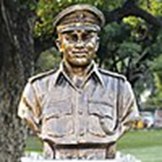 |
Major | Somnath Sharma | Kumaon | 3-11-1947 Indo-Pak | Badgam J&K | Posthumous |
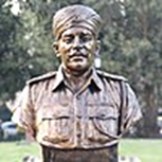 |
Naik | Jadunath Singh | Rajput | 6-2-1947 Indo-Pak | Naushera J & K | Posthumous |
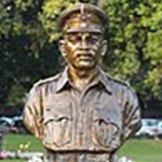 |
Second Lieutenant | Ram Raghoba Rane | Bombay Sappers | 8-4-1947 Indo-Pak | Naushera J & K | |
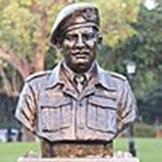 |
Company Havildar Major | Piru Singh | Rajputana Rifles | 17-7-1947 Indo-Pak | Tithwal J & K | Posthumous |
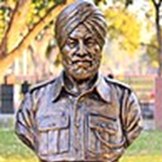 |
Lance Naik | Karam Singh | Sikh | 13-10-1947 Indo-Pak | Tithwal J & K | Posthumous |
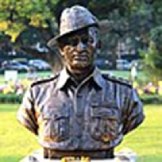 |
Captain | Gurubachan Singh Salaria | Gorkha Rifles | 5-12-1961 Congo | Elizabethville, UN | Posthumous |
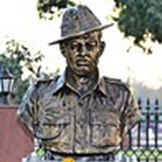 |
Major | Dhan Singh Thapa | Gorkha Rifles | 20-10-1962 Indo-Sino | Ladakh J & K | Posthumous |
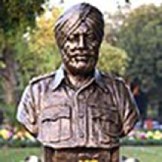 |
Subedar | Joginder Singh | Sikh | 23-10-1961 Indo-Sino | Tongpen La NE Province | Posthumous |
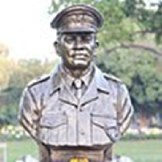 |
Major | Shaitan Singh | Kumaon | 18-11-1962 Indo-Sino | Rezang La J & K | Posthumous |
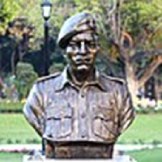 |
Company Quarter Master Havildar | Abdul hamid | Grenadiers | 10-9-1965 Indo-Pak | Asaluttar Khemkaran | Posthumous |
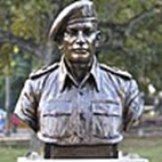 |
Lieutanant Colonel | Ardeshir Tarapore | Poona Horse | 11-9-1965 Indo-Pak | Chawinda Sialkot | Posthumous |
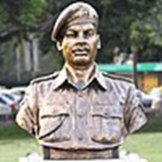 |
Lance Naik | Albert Ekka | Brigade of Guards | 3-12-1971 Indo-Pak | Hilli | Posthumous |
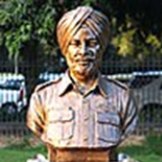 |
Flying Officer | Nirmal Jit Singh Sekhon | No:18 Squadron IAF | 14-12-1971 Indo Pak | Srinagar J & K | Posthumous |
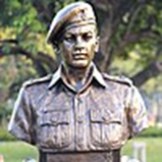 |
Second Lieutenant | Arun Khetarpal | Poona Horse | 16-12-1971 Indo - Pak | Battle of Basantar | Posthumous |
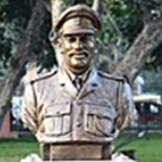 |
Major | Hoshiar Singh Dahiya | Grenadiers | 17-12-1971 | Battle of Basantar | |
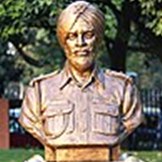 |
Naib Subedar | Bana Singh | J & K Light Infantry | 23-05-1987 Siachin Glacier | Operation Rajiv | |
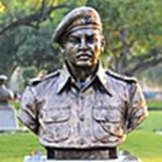 |
Major | Ramaswamy Parameshwaran | Mahar | 26-11-1987 Sri Lanka | operation pawan | |
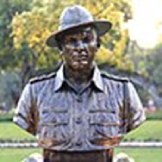 |
Lieutenant | Manoj Kumar Pandey | Gorkha Rifles | 3-7-1999 J & K | Juber Top Kargil War | Posthumous |
 |
Grenadier | Yogendra Singh Yadav | Grenadiers | 4-07-1999 J & K | Kargil War | |
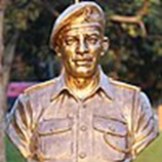 |
Rifle Man | Sanjay Kumar | J & K Rifles | 5-07-1999 J & K | Kargil War | |
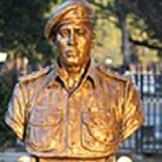 |
Captain | Vikram Batra | J & K Rifles | 7-07-1999 Kargil | J & K | Posthumous |




